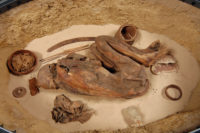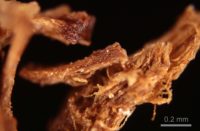 Egypt’s hot, dry desert climate preserved dead bodies long before the advent of artificial mummification. It was long believed that predynastic mummies curled in their characteristic fetal position, were all the product of natural causes, desiccated by the hot sands in which they were buried. A new study has found that a predynastic mummy of the Naqada I (3900-3700 B.C.) period in the collection of Turin’s Museo Egizio was enbalmed, not naturally mummified. That makes him the earliest known example of Egyptian mummification, embalmed 1,500 years before the time when the practice was previously believed to have begun in Egypt.
Egypt’s hot, dry desert climate preserved dead bodies long before the advent of artificial mummification. It was long believed that predynastic mummies curled in their characteristic fetal position, were all the product of natural causes, desiccated by the hot sands in which they were buried. A new study has found that a predynastic mummy of the Naqada I (3900-3700 B.C.) period in the collection of Turin’s Museo Egizio was enbalmed, not naturally mummified. That makes him the earliest known example of Egyptian mummification, embalmed 1,500 years before the time when the practice was previously believed to have begun in Egypt.
The mummy, affectionately known as Fred, was acquired in 1901 by renown Egyptologist Ernesto Schiaparelli who a few years later would go on to discover the tomb of Queen Nefertari at Deir el-Medina. It’s not certain where it came from; the most likely candidate is Gebelein. Schiaparelli was the director of the Museo Egizio for decades and the mummy has been in the museum’s collection since its acquisition. It has never been conserved or treated with modern materials, nor has it been subjected to scientific testing. That’s incredibly rare with mummies of any kind — archaeologists, amateurs, collectors used to tear into them with unfortunate gusto back in the day — and predynastic mummies are already far rarer than pharaonic ones.
 It was this unusual lack of interventions which made the Turin mummy a unique opportunity for researchers to examine for evidence of deliberate mummification techniques. The team had already spent years studying impeccably-provenanced linen wrappings found in early Egyptian pit graves. Examination under a microscope revealed the presence of a toffee-like substance that subsequent chemical tests identified as pine resin, plant gum, a natural petroleum and fat. These same materials were used 3,000 years later at the peak period of Pharaonic mummification.
It was this unusual lack of interventions which made the Turin mummy a unique opportunity for researchers to examine for evidence of deliberate mummification techniques. The team had already spent years studying impeccably-provenanced linen wrappings found in early Egyptian pit graves. Examination under a microscope revealed the presence of a toffee-like substance that subsequent chemical tests identified as pine resin, plant gum, a natural petroleum and fat. These same materials were used 3,000 years later at the peak period of Pharaonic mummification.
Those results were exciting, but they were not entirely convincing because the linens were not attached to any mummies. They were recovered on their own, and while the dating was solid and the discovery recognized by scholars as authentic, the materials could not be conclusively linked to a mummified individual and therefore could not be said to be an example of pre-pharaonic mummification practices. Fred, on the other hand, was the ideal mute witness.
The researchers sampled linen fragments from the mummy’s torso and right wrist, as well as from a woven basket that had been buried alongside the remains. Plant oils and animal fats permeated the ancient fabric, and the scientists pieced together an embalming “recipe” from the compounds that they found, which included sugar or gum, conifer resin, aromatic plant extracts, and antibacterial agents. These ingredients were in similar proportions to those found in balms used during the dynastic period, according to the study.
The Turin mummy is so old that it even predates written language (the earliest known evidence of writing dates to about 3400 B.C.). So, it’s likely that the embalming instructions were preserved verbally “and passed down through generations,” [study author Jana Jones, a research fellow with the Department of Ancient History at Macquarie University in Sydney] said at the briefing.